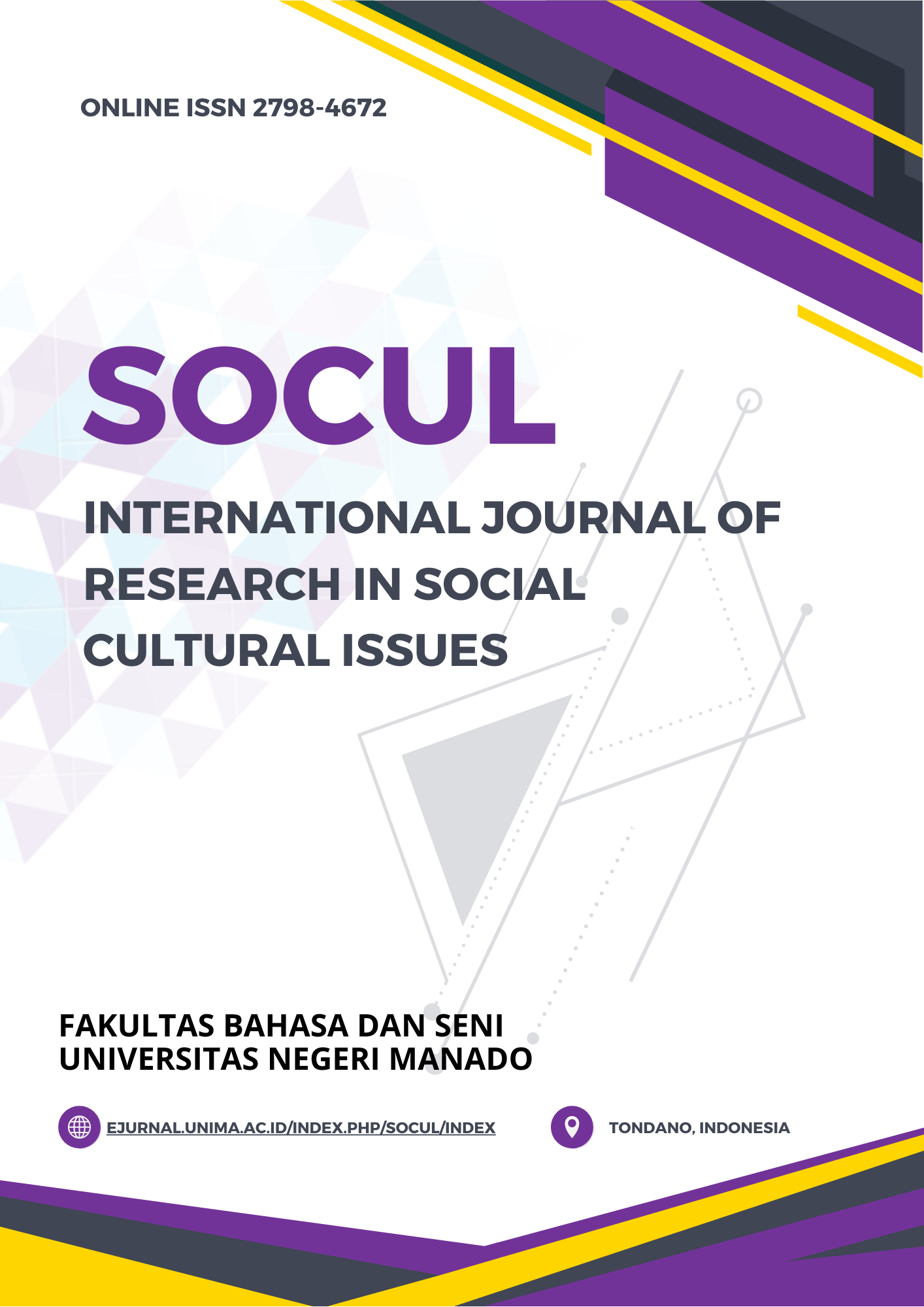A LONG-TERM SURVEY OF JAPANESE LANGUAGE PROFICIENCY OF CLD CHILDREN LIVING IN JAPAN
DOI:
https://doi.org/10.53682/soculijrccsscli.v4i4.12625Keywords:
DLA, Indonesian Children, Indonesian migrant workers, Japanese language proficieny, Long-term surveyAbstract
In Japan, there are several areas where Indonesian migrants live in concentration and in such areas, problems arise about children’s education at schools. A continuous five-year survey on the children of Indonesian migrant workers was conducted to assess their Japanese language proficiency and language skills which are necessary for academic learning, identifying challenges, and implementing improvements. The survey participants were 21 Indonesian children enrolled in the Japanese language class at A Elementary School in an area with a high population of Indonesian migrant workers. These children were born and raised in Japan, and many had lived in Japan for many years having received Japanese language instruction at school. The survey used the Dialogic Language Assessment for Foreign Students (DLA) to measure the children’s abilities. Each year, interviews and tests were conducted to assess their learning progress. Additionally, interviews were conducted with two teachers. There were mainly two findings; (1) Three students who received specialized instruction from elementary school teachers developed reading comprehension and conversational skills comparable to those of native Japanese speakers. (2) Some children showed improvement in their Japanese language proficiency, though they had not yet reached the level of native speakers. Conversely, some children faced serious academic challenges owing to incomplete language proficiency. The survey found out that there was an obvious correlation between reading habits and Japanese proficiency of the children. The study indicated that reading habits apparently contribute to improving language skills.
References
Cummins, J. (1981). Four misconceptions about language proficiency in bilingual education. NABE journal,5(3),31–45. https://doi.org/10.1080/08855072.1981.10668409
Cummins, J. (2001). Bilingual children’s mother tongue: Why is it important for education? Sprogforum,7(19), 15–20. http://www.iteachilearn.com/cummins/mother.htm
Cummins, J. (2011). Bairingaru-ji no bogo—Naze kyōiku-jō jūyō ka [Bilingual children's mother. tongue—Why it is important for education]. In Nakajima, K. (Trans. & Ed.),Gengo Mainoriti o Sasaeru Kyōiku [Education supporting language minorities],61–71. [in Japanese].
Cummins, J. (2021). Rethinking the education of multilingual learners: A critical analysis of. theoretical concepts.Multilingual Matters. https://doi.org/10.1080/14790718.2023.2181352
Fukihara, Y., & Sukegawa, Y. (2012) A Factual Investigation on The Life Situation and. Japanese Language Acquisition of Indonesian Migrant Workers in Oarai Town, Higashi Ibaraki County, Ibaraki prefecture.Fukuoka Women's University studies of international society,1,43-55. https://fwu.repo.nii.ac.jp/records/9 [in Japanese]
Fukihara, Y. (2019) Studies on Children’s Language Acquisition in an Indonesian Community in. Japan:A Preliminary Research Study through DLA (Dialogic Language Assessment), Interviews and Participant Observation.Fukuoka Women's University studies of international society,8,23-32. https://fwu.repo.nii.ac.jp/records/3131 [in Japanese]
Fukihara, Y. (2021). Ijū rōdōsha no Nihongo shūtoku wa susumu no ka [Will migrant workers' Japanese language acquisition progress?].Hitsuji Shobō.[in Japanese].
Fukihara, Y., Sukegawa,Y., Sasaki,R., & Kuwabara,Y. (2023). Ōarai Shōgakkō ni okeru taiwa ni yoru Nihongo nōryoku chōsa [Japanese language proficiency assessment through dialogue at Ōarai Elementary School]. http://www.fwu.ac.jp/~fukihara/pdf/240226_01.pdf [in Japanese].
Kim, C. (2020). “Hattatsu Shōgai” to sareru gaikokujin no kodomo-tachi[Foreign children labeled as having “developmental disabilities”].Akashi Shoten.[in Japanese].
Kobayashi, S. (2024). Chapter 3‘Nihongo’ o manabu koto o aratamete kangaete miru [Chapter 3: Rethinking the learning of “Japanese”]. In Kodomo no Nihongo Kyōiku o Toinaosu [Reexamining children’s Japanese language education]. Akashi Shoten.[in Japanese].
Kobayashi, Y., Kanchō, R., Sakurai, C.,Nagata, K.,& Itō, Y.(2015).Tokubetsu kyōiku katei no naka de no DLA no ikashikata [Utilizing the DLA in special education curricula].2015 Nihongo Kyōiku Gakkai Shūki Taikai Yokōshū [Proceedings of the 2015 Autumn Conference of the Society for Teaching Japanese as a Foreign Language],49-60.[in Japanese].
Majima, J., & Sakurai, C. (2015). Kōritsu shōgakkō de manabu CLD-ji no nigen-go nōryoku no hattatsu— ‘Taiwa-gata asesumento’ o riyō shita 5-nenkan no chōsa hōkoku[Development. of bilingual proficiency in CLD children studying at public elementary schools: A five-year study using “Dialogic Assessment”].2015 Nihongo Kyōiku Gakkai Shūki Taikai Yokōshū [Proceedings of the 2015 Autumn Conference of the Society for Teaching Japanese as a Foreign Language],194–199. [in Japanese].
Majima,J., & Sakurai, C. (2019). Dai 5-shō Teijū nisei-ji no nigen-go nōryoku no jūdan kenkyū [Chapter 5: A longitudinal study on the bilingual proficiency of second-generation settler children]. In Bogo o nakusanai Nihongo kyōiku wa kanō ka—Teijū nisei-ji no nigen-go nōryoku[Is Japanese language education possible without losing the mother tongue?—bilingual proficiency of second-generation settler children].Osaka University Press.[in Japanese].
Ministry of Education, Culture, Sports, Science and Technology (MEXT), Japan. (2025, January 31). Survey on the Enrollment Status of Students Requiring Japanese Language Instruction (FY 2023). https://www.mext.go.jp/content/20240808-mxt_kyokoku-000037366_4.pdf(Accessed: August 6, 2024) [in Japanese].
Ministry of Education, Culture, Sports, Science and Technology (MEXT), Japan, International Education Division, Elementary and Secondary Education Bureau.(2014).JSL Dialogic Language Assessment (DLA) for Foreign Students. https://www.mext.go.jp/component/a_menu/education/micro_detail/__icsFiles/afieldfile/2018/05/24/1405244_1.pdf(Accessed: August 6, 2024) [in Japanese].
Mitsuya, M., & Yada, H. (2025). Tadoku Reading Event for Young Learners of Japanese as a Heritage Language.The Japan Foundation Journal on Japanese-language Education, 21,75-87. https://doi.org/10.20649/0002000353 [in Japanese]
Miyajima, T. (2014). Gaikokujin no kodomo no kyōiku—Shūgaku no genjō to kyōiku o ukeru kenri [Education of foreign children: The current state of school enrollment and the right to education]. University of Tokyo Press. [in Japanese].
Okazaki, W. (2022). Kodomo no Nihongo Kyōiku[Children’s Japanese Language Education]. webjapanese Booklet. [in Japanese].
Sakurai, C. (2018). Gaikoku ni rūtsu o motsu kodomo no bairingaru dokushoryoku[Bilingual reading proficiency of children with foreign roots].Osaka University Press.[in Japanese].
Skutnabb-Kangas, T. (1981). Bilingualism or not: The education of minorities. Multilingual Matters.
Tanaka, N., Sunohara,K., & Yamada,I.(2012). Ikiru chikara o tsuchikau kotoba—Gengoteki mainoriti ga koe o motsu tame ni [Cultivating the power to live through language: Enabling linguistic minorities to have a voice]. Taishukan Shoten.[in Japanese].














